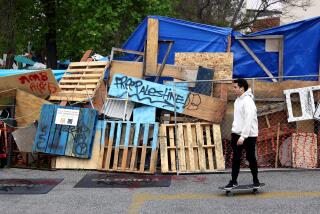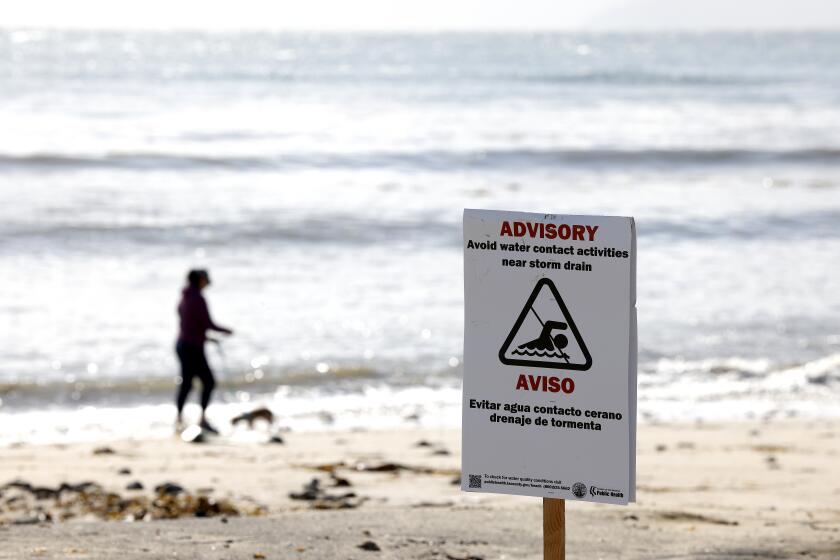Study Suggests a Hostile Highway
A survey of Orange County motorists by a UC Irvine psychologist suggests that aggressive and violent behavior is surprisingly frequent among drivers, with nearly a third reporting that they have angrily chased another driver.
Nearly 27% of the 480 drivers surveyed reported they knew someone who carried a gun in his or her car, according to Raymond W. Novaco, an associate professor who specializes in studying human aggression. Among men, about 17% admitted throwing an object at another car, and nearly 11% admitted bumping or ramming another car in anger.
No one admitted firing at another car, but one man said he threatened another driver with a gun. Five people reported being shot at.
Novaco said the survey results are preliminary and yet to be scientifically validated. But he said the continuing survey probably will augment his findings that last summer’s series of Southern California freeway shootings was not an outbreak of hostility limited to that time and region.
There were freeway homicides in Texas and Florida before the outbreak in Southern California, he said. A shooting outbreak occurred in St. Louis at almost the same time as Southern California’s.
And “people haven’t stopped doing it. There have been a number of other shootings,” Novaco said. They are probably more frequent than people generally realize, he said.
Novaco stressed that his study will not explain the reason for roadway violence, but in the introduction to his preliminary data, he reviewed some of the popular explanations he described as “misguided.”
He conceded that it is true that an automobile--named by its manufacturer Charger, Cutlass, Challenger or something equally aggressive--provides a means of asserting dominance and often is viewed by a driver as his or her territorial entity.
“Because the automobile affords anonymity and the opportunity to escape, it can be a fleeing mini-fortress from which aggression can burst and where inhibitions about harm-doing are often switched off.”
Novaco’s nine-page questionnaire was answered by 286 UCI undergraduates in April and by 182 people enrolled in the Harbor Municipal Court traffic school earlier this month. Women constituted 56% of the combined group.
Results Generally Coincided
Novaco said flagrant traffic offenders or violators who have been cited within the previous two years are not allowed to go to traffic school. Therefore, the traffic school students probably fall within the mainstream of Orange County drivers, he said, an assumption that will be verified before the study is complete, he said.
The results from the student groups generally coincided with those from the traffic school group, he said.
“These data show a considerable amount of provocative and antagonistic behavior,” Novaco wrote. “For example, 16.7% of the subjects (24 males, 24 females) report yelling at someone each week, and 6.3% (16 males, two females) say that they gesture obscenely on a weekly basis.
“Such findings are troublesome,” Novaco wrote, because some drivers in a confrontation are more willing “to escalate it to harm-doing conclusions. Consequently, it is surely a mistake . . . to become ensnared in a road dispute. To do so is to engage in an ego-oriented script that has a very bad ending.”
The study, partially funded by the Drivetime Foundation in Los Angeles, will continue with surveys of traffic school students in other Orange County Municipal Court districts, Novaco said.
The final report will include all elements in the questionnaire, such as age, education, driving record, attitudes, driving habits and type of vehicles driven. The study might lead to a profile of the typical violent driver, he said.
But, Novaco added, “violence is a significantly different matter than impatience or even anger. . . .” It takes more than “traffic stress” to explain why people cross over the line toward violence.
It is likely, Novaco wrote, “that some of those who did the roadway shootings would have engaged in some other form of aggression if this particular script had not been available to enact.”
On the other hand, some shootings were by seemingly model citizens, such as the case of a prominent New York investment banker who shot an unarmed college student outside the city during a road dispute in June.
Nor does the “copycat” theory apply in the great majority of cases, since the shootings followed disputes, Novaco wrote. “The idea of copycat is that people just go out and duplicate something they saw. It leaves out the other factors, just as the ‘traffic stress’ explanation does. Traffic stress is not irrelevant. Copycat is not irrelevant. It’s just an oversimplification.”
Previous studies have shown that merely driving a car in congested traffic causes “physiological arousal”--an increase in blood pressure, increases in negative moods, a lowered tolerance for frustration and increased impatience, Novaco said. In this state, aggressive tendencies are less inhibited, he said.
What Novaco terms “impedence” sets in--the perception by the driver that he or she is being blocked.
‘You Can’t Escape’
The mere perception is probably not enough to trigger violence, he wrote. The worst congestion--the rush-hour stop and start of the freeway--is the worst place for an attack “because you can’t escape.”
But if other factors accompany the feeling of impedence, aggression and even violence may ensue.
Among those factors is the “aggressive script” provided, mainly by news and entertainment media, Novaco said. “There have been enough movies, enough TV programs, where shootings and car chases have gone on, so the script is there mentally.”
Seeing these examples does not compel a person to simulate them. “They don’t see it in the paper and decide to do it too,” Novaco said. But when the driver falls into a similar circumstance, “it gives it some legitimacy. It’s a script to follow,” Novaco said.
This tendency is intensified in what is termed a “community contagion,” when some novel activity is repeated, reported, repeated, reported more prominently, and so forth in a growing cycle.
Novaco said the effect of news reports on such a contagion “hasn’t been investigated,” but one mathematical study showed that one-car fatalities in which only the driver was aboard increased markedly after news reports of suicides--and only in the areas where the suicides were reported. While it is unlikely that suicides--or freeway shooters--do their deeds for publicity, the study hints at the possibility of news reports providing the “script” for such outbreaks, Novaco said.
Novaco said the effort to find the reasons for roadway violence is hindered by the lack of experimentation--and the unwillingness to experiment. “It is not a situation one would want to duplicate,” he said.
TRAFFIC VIOLENCE SURVEY RESULTS These are preliminary results from 468 questionnaires answered by 286 UC Irvine undergraduates during April, 1988, and by 182 people enrolled in traffic school at Harbor Municipal Court during July, 1988.
% Men % Women % Overall WEAPONS Carry gun in car 0.5 0.4 0.4 Know someone who carries gun in car 33.5 21.5 26.7 Carry other weapon in car 15.3 1.9 7.9 Carried weapon before summer, 14.3 1.1 7.3 1987, shootings ALTERCATIONS Argument with threat of violence 39.9 16.9 27.1 Fight with physical contact 9.4 0.8 4.7 PERPETRATORS Have shot 0 0 0 Have threatened with a gun 1.5 0 0.6 Have bumped or rammed 10.8 2.7 6.4 Have thrown object 17.2 5.0 10.3 Have chased another driver 43.3 17.6 28.8 Occurring weekly or more frequently: Used obscene gesture 12.3 2.7 7.1 Yelled at another driver 21.2 13.4 16.9 Honked in annoyance 13.8 7.7 10.3 Abruptly cut someone off 17.2 10.7 13.5 Followed extremely closely 12.8 5.7 8.8 Flashed high beams 6.4 2.3 4.1 Stopped abruptly in front 4.4 5.0 4.7 VICTIMS Shot at 1.0 0.8 1.1 Threatened with a gun 3.9 1.1 2.6 Bumped or rammed 17.7 8.0 12.6 Object thrown at them 35.0 25.7 29.7 Chased by another driver 41.4 37.9 39.5 Occurring weekly or more frequently: Received obscene gesture 7.4 3.8 5.3 Yelled at 6.4 4.6 5.3 Honked at in annoyance 5.9 6.5 6.2 Abruptly cut off 59.1 55.6 56.8 Someone followed extremely closely 35.5 24.5 29.5 Someone flashed high beams 9.9 6.5 8.1 Abrupt stop in front 31.5 29.1 29.9
More to Read
Start your day right
Sign up for Essential California for news, features and recommendations from the L.A. Times and beyond in your inbox six days a week.
You may occasionally receive promotional content from the Los Angeles Times.






